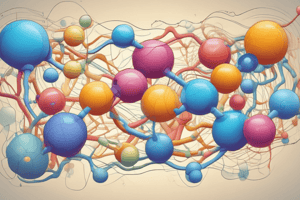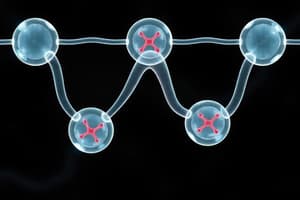Podcast
Questions and Answers
What is the primary pathway through which cells perform glycolysis?
What is the primary pathway through which cells perform glycolysis?
Embden-Meyerhof (Warburg) Pathway
Which products are generated from glycolysis?
Which products are generated from glycolysis?
- Pyruvate
- ATP
- NADH
- All of the above (correct)
What is the initial substrate used in glycolysis?
What is the initial substrate used in glycolysis?
Glucose
What is the function of hexokinase in glycolysis?
What is the function of hexokinase in glycolysis?
Glucokinase has a lower Km value for glucose compared to hexokinase.
Glucokinase has a lower Km value for glucose compared to hexokinase.
What activates phosphofructokinase (PFK) in glycolysis?
What activates phosphofructokinase (PFK) in glycolysis?
What is the net ATP yield from one cycle of glycolysis?
What is the net ATP yield from one cycle of glycolysis?
What type of phosphorylation occurs during ATP synthesis in glycolysis?
What type of phosphorylation occurs during ATP synthesis in glycolysis?
What happens to NADH under aerobic conditions during glycolysis?
What happens to NADH under aerobic conditions during glycolysis?
Which enzyme facilitates the conversion of phosphoenolpyruvate (PEP) to pyruvate?
Which enzyme facilitates the conversion of phosphoenolpyruvate (PEP) to pyruvate?
Flashcards are hidden until you start studying
Study Notes
Overview of Glycolysis
- Glycolysis is a universal metabolic pathway occurring in nearly all cells.
- Consists of ten reactions categorized into two phases: conversion of glucose to two G-3-P and processing those to two pyruvates.
- Key products include pyruvate, ATP, and NADH.
- Pyruvate can undergo three potential fates depending on aerobic or anaerobic conditions.
First Phase of Glycolysis
- First reaction involves phosphorylation of glucose by hexokinase or glucokinase; this is a priming step consuming ATP for energy gain later.
- Hexokinase: has a low Km (0.1 mM), indicating high affinity for glucose, making it active under normal glucose levels (4 mM).
- Glucokinase: present in liver and pancreas, has a higher Km (10 mM) and activates only when glucose is abundant, slowing down glycolysis for glycogen synthesis.
Key Reactions in First Phase
-
Rx 2: Phosphoglucoisomerase
- Converts glucose-6-phosphate to fructose-6-phosphate, facilitating activation for subsequent reactions.
-
Rx 3: Phosphofructokinase (PFK)
- Serves as the committed step in glycolysis, highly regulated by ATP (inhibitory), AMP (activatory), and citrate (inhibitory).
- Fructose-2,6-bisphosphate acts as an allosteric activator, enhancing PFK activity when energy is low.
Second Phase of Glycolysis
- Results in a net yield of two ATP from substrate-level phosphorylation, generating four ATP overall.
- High-energy intermediates, 1,3-BPG and phosphoenolpyruvate (PEP), play crucial roles in the energy payoff phase.
Key Reactions in Second Phase
-
Rx 6: Glyceraldehyde-3-Phosphate Dehydrogenase
- Converts G-3-P into 1,3-BPG, generating NADH in the process and utilizing energy from transforming aldehyde to carboxylic acid.
-
Rx 7: Phosphoglycerate Kinase
- Enables ATP synthesis from high-energy phosphate substrates through substrate-level phosphorylation.
-
Rx 9: Enolase
- Converts 2-phosphoglycerate to PEP, rearranging to release more energy in subsequent hydrolysis.
-
Rx 10: Pyruvate Kinase
- Converts PEP to pyruvate, producing ATP; regulated by AMP (activator) and ATP/acetyl-CoA (inhibitors).
- Conversion involves a spontaneous enol-keto tautomerization that releases free energy.
The Fate of NADH and Pyruvate
- NADH can be oxidized via aerobic respiration in the electron transport chain to generate ATP during aerobic conditions.
- In anaerobic conditions, lactate dehydrogenase re-oxidizes NADH to NAD+, allowing glycolysis to continue despite lack of oxygen.
Studying That Suits You
Use AI to generate personalized quizzes and flashcards to suit your learning preferences.




